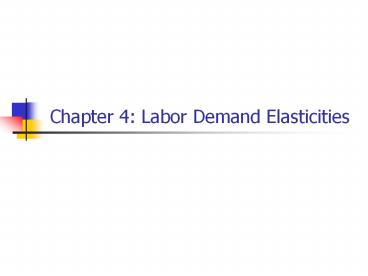Chapter 4: Labor Demand Elasticities - PowerPoint PPT Presentation
Title:
Chapter 4: Labor Demand Elasticities
Description:
Chapter 4: Labor Demand Elasticities Own-wage Elasticity of Labor Demand Elasticity and Slope Slope involves a relationship between the change in the level of the ... – PowerPoint PPT presentation
Number of Views:234
Avg rating:3.0/5.0
Title: Chapter 4: Labor Demand Elasticities
1
Chapter 4 Labor Demand Elasticities
2
Own-wage Elasticity of Labor Demand
Labor demand is said to be
3
Elasticity and Slope
- Slope involves a relationship between the change
in the level of the wage and a change in the
level of employment. Elasticity involves a
relationship between percentage changes in these
variables. - A constant change in the level of a variable will
not result in a constant percentage change in
that variable.
4
Elasticity and Slope
- Note, for example that
- an increase from 1 to 2 is a 100 increase,
- an increase from 2 to 3 is a 50 increase,
- an increase from 3 to 4 is a 33 increase,
- an increase from 4 to 5 is a 25 increase,
- an increase from 10 to 11 is a 10 increase, and
- an increase from 100 to 101 is a 1 increase.
5
Elasticity Along a Linear Demand Curve
6
Elasticity Along a Linear Demand Curve
7
Elasticity and Slope Comparisons
8
Determinants of Own-wage Elasticity of Labor
Demand
Labor demand will be more elastic when
- the substitution effect is larger, and/or
- the scale effect is larger
9
Hicks-Marshall Laws of Derived Demand
Own-wage elasticity of labor demand is relatively
high when
- the price elasticity of demand for the final
product is relatively high, - tt is relatively easy to substitute other factors
for this category of labor, - the supply of other factors of production is
relatively elastic, and - this category of labor accounts for a relatively
large share of total costs.
10
First Hicks-Marshall Law
- Own-wage elasticity of demand is relatively high
when the price elasticity of demand for the final
product is relatively high. - This works through the scale effect
- Higher wages result in higher average and
marginal costs, - Higher costs result in a higher product price,
- Higher prices result in a reduction in the
quantity of the product demanded, - A reduction in sales results in a reduction in
output and in input use.
11
Second Hicks-Marshall Law
- Own-wage elasticity of labor demand will be
relatively high when it is relatively easy to
substitute other factors for this category of
labor. - This law works through the substitution effect.
12
Third Hicks-Marshall Law
- Own-wage elasticity of labor demand is relatively
high when the price elasticity of supply is
relatively high for other factors of production. - This law works through the substitution effect.
13
Fourth Hicks-Marshall Law
- Own-wage elasticity is relatively large when this
category of labor accounts for a relatively large
share of total costs - This law works through the scale effect
- Higher wages result in higher average and
marginal costs, - Higher costs result in a higher product price,
- Higher prices result in a reduction in the
quantity of the product demanded, - A reduction in sales results in a reduction in
output and in input use.
14
Hicks-Marshall Laws and Union Strategy
- unions will be more successful in receiving wage
increases in markets in which labor demand is
relatively inelastic, - unions will attempt to reduce the own-wage
elasticity of demand for their workers, and - unions might prefer to organize those labor
markets in which labor demand is relatively
inelastic.
15
Hicks-Marshall Laws and Union Strategy
- price elasticity of demand for the final product,
- ease of substitution of other inputs,
- supply elasticity of other inputs,
- labors share of total costs.
16
Cross-wage (Cross-price) Elasticity of Demand
- A positive cross-price elasticity of demand
between two inputs indicates that the two inputs
are gross substitutes. - Two inputs are gross complements if the
cross-price elasticity is negative.
17
Empirical Estimates of Cross-wage Elasticities
- labor and energy are substitutes,
- labor and materials are substitutes,
- skilled workers are more likely to be gross
complements with capital than are unskilled
workers, and - there is little complementarity or substitution
between immigrant and native workers.
18
Minimum Wage Effects
- minimum wages are specified in nominal, not real
terms. - employment reduction under perfect competition
and complete coverage
19
Minimum Wage Effects - Noncovered Sector
20
Minimum wage (or union) in a monopsony
21
Summary of Minimum Wage Theory
- A minimum wage is expected to result in
- unemployment and economic inefficiency if the
labor market is perfectly competitive and there
is complete coverage, - economic inefficiency if the labor market is
perfectly competitive and there is a non-covered
sector, and - an ambiguous effect on the level of employment if
firms possess some degree of monopsony power.
22
Empirical Results
- early studies suggested a negative effect on
teenage unemployment, - recent studies suggest little or no impact,
- effect on poverty is limited (only 22 of minimum
wage workers live in households with income below
the poverty level).
23
Technological Change
- lower cost and higher quality products,
- shifts in pattern of labor demand,
- automation is approximately equivalent to a
reduction in the price of capital -- thus, it
results in substitution and scale effects, - no evidence of increased aggregate unemployment
due to technological change.































